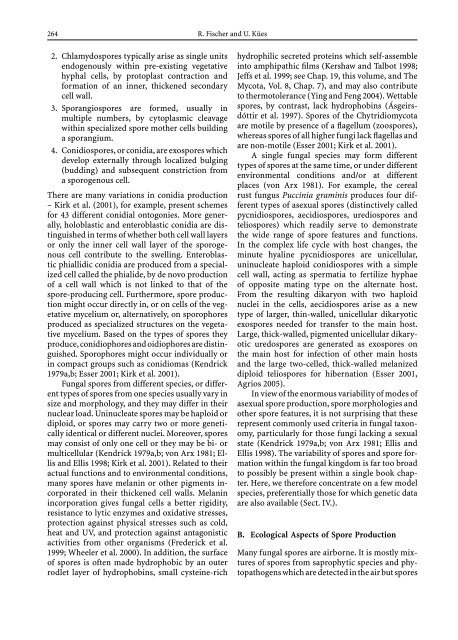Growth, Differentiation and Sexuality
Growth, Differentiation and Sexuality
Growth, Differentiation and Sexuality
You also want an ePaper? Increase the reach of your titles
YUMPU automatically turns print PDFs into web optimized ePapers that Google loves.
264 R. Fischer <strong>and</strong> U. Kües<br />
2. Chlamydospores typically arise as single units<br />
endogenously within pre-existing vegetative<br />
hyphal cells, by protoplast contraction <strong>and</strong><br />
formation of an inner, thickened secondary<br />
cell wall.<br />
3. Sporangiospores are formed, usually in<br />
multiple numbers, by cytoplasmic cleavage<br />
within specialized spore mother cells building<br />
a sporangium.<br />
4. Conidiospores, or conidia, are exospores which<br />
develop externally through localized bulging<br />
(budding) <strong>and</strong> subsequent constriction from<br />
asporogenouscell.<br />
There are many variations in conidia production<br />
– Kirk et al. (2001), for example, present schemes<br />
for 43 different conidial ontogonies. More generally,<br />
holoblastic <strong>and</strong> enteroblastic conidia are distinguished<br />
in terms of whether both cell wall layers<br />
or only the inner cell wall layer of the sporogenous<br />
cell contribute to the swelling. Enteroblastic<br />
phiallidic conidia are produced from a specialized<br />
cell called the phialide, by de novo production<br />
of a cell wall which is not linked to that of the<br />
spore-producing cell. Furthermore, spore production<br />
might occur directly in, or on cells of the vegetative<br />
mycelium or, alternatively, on sporophores<br />
produced as specialized structures on the vegetative<br />
mycelium. Based on the types of spores they<br />
produce, conidiophores <strong>and</strong> oidiophores are distinguished.<br />
Sporophores might occur individually or<br />
in compact groups such as conidiomas (Kendrick<br />
1979a,b; Esser 2001; Kirk et al. 2001).<br />
Fungal spores from different species, or different<br />
types of spores from one species usually vary in<br />
size <strong>and</strong> morphology, <strong>and</strong> they may differ in their<br />
nuclear load. Uninucleate spores may be haploid or<br />
diploid, or spores may carry two or more genetically<br />
identical or different nuclei. Moreover, spores<br />
may consist of only one cell or they may be bi- or<br />
multicellular (Kendrick 1979a,b; von Arx 1981; Ellis<br />
<strong>and</strong> Ellis 1998; Kirk et al. 2001). Related to their<br />
actual functions <strong>and</strong> to environmental conditions,<br />
many spores have melanin or other pigments incorporated<br />
in their thickened cell walls. Melanin<br />
incorporation gives fungal cells a better rigidity,<br />
resistance to lytic enzymes <strong>and</strong> oxidative stresses,<br />
protection against physical stresses such as cold,<br />
heat <strong>and</strong> UV, <strong>and</strong> protection against antagonistic<br />
activities from other organisms (Frederick et al.<br />
1999; Wheeler et al. 2000). In addition, the surface<br />
of spores is often made hydrophobic by an outer<br />
rodlet layer of hydrophobins, small cysteine-rich<br />
hydrophilic secreted proteins which self-assemble<br />
into amphipathic films (Kershaw <strong>and</strong> Talbot 1998;<br />
Jeffs et al. 1999; see Chap. 19, this volume, <strong>and</strong> The<br />
Mycota, Vol. 8, Chap. 7), <strong>and</strong> may also contribute<br />
to thermotolerance (Ying <strong>and</strong> Feng 2004). Wettable<br />
spores, by contrast, lack hydrophobins (Ásgeirsdóttir<br />
et al. 1997). Spores of the Chytridiomycota<br />
are motile by presence of a flagellum (zoospores),<br />
whereas spores of all higher fungi lack flagellas <strong>and</strong><br />
are non-motile (Esser 2001; Kirk et al. 2001).<br />
A single fungal species may form different<br />
types of spores at the same time, or under different<br />
environmental conditions <strong>and</strong>/or at different<br />
places (von Arx 1981). For example, the cereal<br />
rust fungus Puccinia graminis produces four different<br />
types of asexual spores (distinctively called<br />
pycnidiospores, aecidiospores, urediospores <strong>and</strong><br />
teliospores) which readily serve to demonstrate<br />
the wide range of spore features <strong>and</strong> functions.<br />
Inthecomplexlifecyclewithhostchanges,the<br />
minute hyaline pycnidiospores are unicellular,<br />
uninucleate haploid conidiospores with a simple<br />
cell wall, acting as spermatia to fertilize hyphae<br />
of opposite mating type on the alternate host.<br />
From the resulting dikaryon with two haploid<br />
nuclei in the cells, aecidiospores arise as a new<br />
type of larger, thin-walled, unicellular dikaryotic<br />
exospores needed for transfer to the main host.<br />
Large, thick-walled, pigmented unicellular dikaryotic<br />
uredospores are generated as exospores on<br />
the main host for infection of other main hosts<br />
<strong>and</strong> the large two-celled, thick-walled melanized<br />
diploid teliospores for hibernation (Esser 2001,<br />
Agrios 2005).<br />
In view of the enormous variability of modes of<br />
asexual spore production, spore morphologies <strong>and</strong><br />
other spore features, it is not surprising that these<br />
represent commonly used criteria in fungal taxonomy,<br />
particularly for those fungi lacking a sexual<br />
state (Kendrick 1979a,b; von Arx 1981; Ellis <strong>and</strong><br />
Ellis 1998). The variability of spores <strong>and</strong> spore formation<br />
within the fungal kingdom is far too broad<br />
to possibly be present within a single book chapter.<br />
Here, we therefore concentrate on a few model<br />
species, preferentially those for which genetic data<br />
are also available (Sect. IV.).<br />
B. Ecological Aspects of Spore Production<br />
Many fungal spores are airborne. It is mostly mixtures<br />
of spores from saprophytic species <strong>and</strong> phytopathogens<br />
which are detected in the air but spores

















